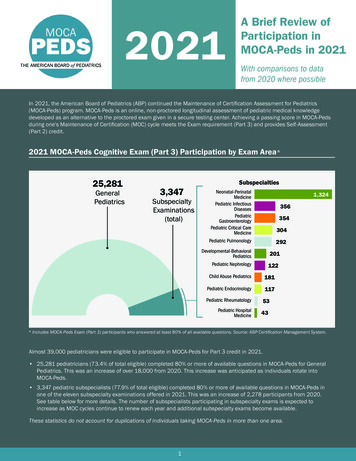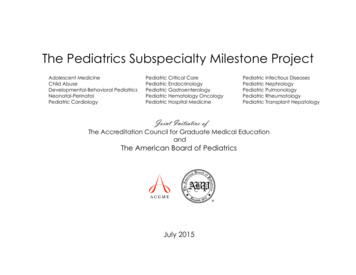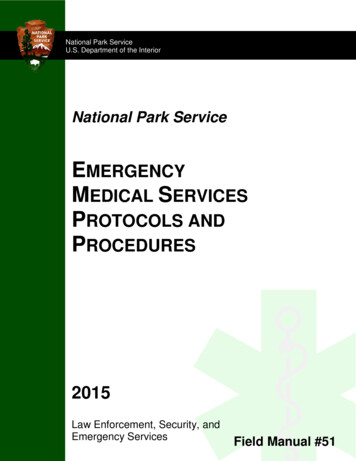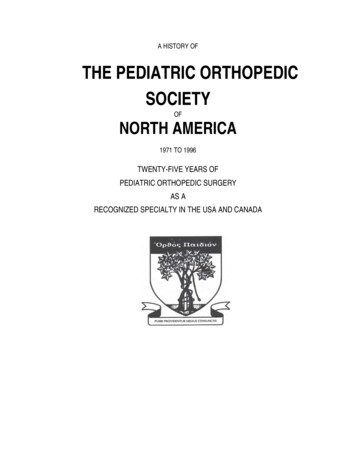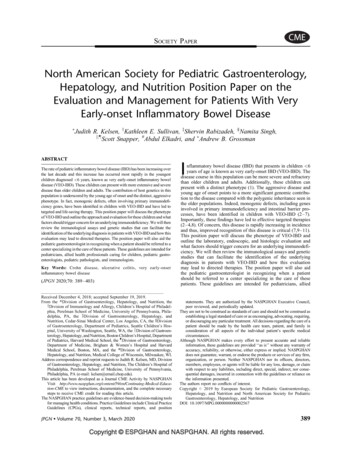
Transcription
SOCIETY PAPERNorth American Society for Pediatric Gastroenterology,Hepatology, and Nutrition Position Paper on theEvaluation and Management for Patients With VeryEarly-onset Inflammatory Bowel Disease Judith R. Kelsen, yKathleen E. Sullivan, zShervin Rabizadeh, §Namita Singh,jjôScott Snapper, #Abdul Elkadri, and Andrew B. GrossmanDownloaded from https://journals.lww.com/jpgn by BhDMf5ePHKav1zEoum1tQfN4a x IQDVs 11EfvIFL46etICVsnwu06p0 on 04/29/2020ABSTRACTThe rate of pediatric inflammatory bowel disease (IBD) has been increasing overthe last decade and this increase has occurred most rapidly in the youngestchildren diagnosed 6 years, known as very early-onset inflammatory boweldisease (VEO-IBD). These children can present with more extensive and severedisease than older children and adults. The contribution of host genetics in thispopulation is underscored by the young age of onset and the distinct, aggressivephenotype. In fact, monogenic defects, often involving primary immunodeficiency genes, have been identified in children with VEO-IBD and have led totargeted and life-saving therapy. This position paper will discuss the phenotypeof VEO-IBD and outline the approach and evaluation for these children and whatfactors should trigger concern for an underlying immunodeficiency. We will thenreview the immunological assays and genetic studies that can facilitate theidentification of the underlying diagnosis in patients with VEO-IBD and how thisevaluation may lead to directed therapies. The position paper will also aid thepediatric gastroenterologist in recognizing when a patient should be referred to acenter specializing in the care of these patients. These guidelines are intended forpediatricians, allied health professionals caring for children, pediatric gastroenterologists, pediatric pathologists, and immunologists.Key Words: Crohn disease, ulcerative colitis, very early-onsetinflammatory bowel disease(JPGN 2020;70: 389–403)Received December 4, 2018; accepted September 19, 2019.From the Division of Gastroenterology, Hepatology, and Nutrition, theyDivision of Immunology and Allergy, Children’s Hospital of Philadelphia, Perelman School of Medicine, University of Pennsylvania, Philadelphia, PA, the zDivision of Gastroenterology, Hepatology, andNutrition, Cedar-Sinai Medical Center, Los Angeles, CA, the §Divisionof Gastroenterology, Department of Pediatrics, Seattle Children’s Hospital, University of Washington, Seattle, WA, the jjDivision of Gastroenterology, Hepatology, and Nutrition, Boston Children’s Hospital, Departmentof Pediatrics, Harvard Medical School, the ôDivision of Gastroenterology,Department of Medicine, Brigham & Women’s Hospital and HarvardMedical School, Boston, MA, and the #Division of Gastroenterology,Hepatology, and Nutrition, Medical College of Wisconsin, Milwaukee, WI.Address correspondence and reprint requests to Judith R. Kelsen, MD, Divisionof Gastroenterology, Hepatology, and Nutrition, The Children’s Hospital ofPhiladelphia, Perelman School of Medicine, University of Pennsylvania,Philadelphia, PA (e-mail: kelsen@email.chop.edu).This article has been developed as a Journal CME Activity by NASPGHANVisit edical-Education-CME to view instructions, documentation, and the complete necessarysteps to receive CME credit for reading this article.The NASPGHAN practice guidelines are evidence-based decision-making toolsfor managing health conditions. Practice Guidelines include Clinical PracticeGuidelines (CPGs), clinical reports, technical reports, and positionJPGN Inflammatory bowel disease (IBD) that presents in children 6years of age is known as very early-onset IBD (VEO-IBD). Thedisease course in this population can be more severe and refractorythan older children and adults. Additionally, these children canpresent with a distinct phenotype (1). The aggressive disease andyoung age of onset points to a more significant genomic contribution to the disease compared with the polygenic inheritance seen inthe older populations. Indeed, monogenic defects, including genesinvolved in primary immunodeficiency and intestinal barrier processes, have been identified in children with VEO-IBD (2–7).Importantly, these findings have led to effective targeted therapies(2–4,8). Of concern, this disease is rapidly increasing in incidenceand thus, improved recognition of this disease is critical (7,9–11).This position paper will discuss the phenotype of VEO-IBD andoutline the laboratory, endoscopic, and histologic evaluation andwhat factors should trigger concern for an underlying immunodeficiency. We will then review the immunological assays and geneticstudies that can facilitate the identification of the underlyingdiagnosis in patients with VEO-IBD and how this evaluationmay lead to directed therapies. The position paper will also aidthe pediatric gastroenterologist in recognizing when a patientshould be referred to a center specializing in the care of thesepatients. These guidelines are intended for pediatricians, alliedstatements. They are authorized by the NASPGHAN Executive Council,peer reviewed, and periodically updated.They are not to be construed as standards of care and should not be construed asestablishing a legal standard of care or as encouraging, advocating, requiring,or discouraging any particular treatment. All decisions regarding the care of apatient should be made by the health care team, patient, and family inconsideration of all aspects of the individual patient’s specific medicalcircumstances.Although NASPGHAN makes every effort to present accurate and reliableinformation, these guidelines are provided ‘‘as is’’ without any warranty ofaccuracy, reliability, or otherwise, either express or implied. NASPGHANdoes not guarantee, warrant, or endorse the products or services of any firm,organization, or person. Neither NASPGHAN nor its officers, directors,members, employees, or agents will be liable for any loss, damage, or claimwith respect to any liabilities, including direct, special, indirect, nor consequential damages, incurred in connection with the guidelines or reliance onthe information presented.The authors report no conflicts of interest.Copyright # 2019 by European Society for Pediatric Gastroenterology,Hepatology, and Nutrition and North American Society for PediatricGastroenterology, Hepatology, and NutritionDOI: 10.1097/MPG.0000000000002567Volume 70, Number 3, March 2020Copyright ESPGHAN and NASPGHAN. All rights reserved.389
Kelsen et alJPGNhealth professionals caring for children, pediatric gastroenterologists, pediatric pathologists, and immunologists.EPIDEMIOLOGYApproximately 6 to 15% of the pediatric IBD populationpresents at 6 years of age, including, although rare, childrendiagnosed in the first year of life (9). The phenotype of VEO-IBD isheterogeneous and while some children have mild disease, otherscan present with more extensive and severe disease than older onsetpediatric and adult IBD (12–15). Due to the more aggressivephenotype, early age of onset, and strong family history, a subsetof VEO-IBD is now considered to be a monogenic disease, ofteninvolving genes associated with primary immunodeficiencies (16–18). Other factors, however, contribute to the development of VEOIBD (and IBD in general) as well, including environmental exposures. Supportive of this notion is the rise in incidence of VEO-IBDfrom 1.3 to 2.1 per 100,000 children from 1994 to 2009, with a meanannual incidence of 7.2% (9). Prominent among the environmentalexposures is the gut microbiome, which develops between birth and3 years of age, coincident with the onset of disease in many cases ofVEO-IBD (19). Exposures, such as route of delivery, gestationalage, maternal diet, and infant feeding practices shape the colonization of infants’ microbiome and can impact health and disease. Theimmune system also develops during these first 3 years of life, andis similarly influenced by the infant’s exposures and by the gutmicrobiome. In fact, the immune system and the gut microbiomeeducate and regulate one another as they mature (20). This interaction is well balanced in healthy children; however, disruptions indevelopment of either structure may lead to disease. Thus, inaddition to the genetic investigations being performed in thispopulation, there are several ongoing studies examining the association between the intestinal microbiome and VEO-IBD.DISEASE CLASSIFICATIONChildren who are diagnosed with IBD in the first 2 years oflife are often referred to as infantile onset IBD, and those diagnosedbetween 2 and 6 years of age are classified as VEO-IBD. Approximately 40% of children with infantile and VEO-IBD have extensivecolonic disease (pancolitis) at presentation (7,13); however, theextent and location of disease can change and progress, making itdifficult to differentiate ulcerative colitis (UC) from Crohn disease(CD). For example, initial isolated colonic disease can extendovertime to include the small bowel (21). Furthermore, while theendoscopic findings often show a colonic distribution of disease,over time, the histology in some of these children can change anddemonstrate features consistent with CD, such as granulomas orduodenal villous blunting. These findings can have importantimplications when determining the appropriate surgical approachin patients with severe colitis. Therefore, IBD-unclassified (IBD-U)is diagnosed more often in patients with VEO-IBD (11%–22%) ascompared with older onset IBD (4%–10%) (14,15,22,23).UNIQUE GENOMICS OF VERY EARLY-ONSETINFLAMMATORY BOWEL DISEASEAlthough the rate of genetic discoveries is increasing, monogenic defects have been detected in only approximately 15% to20%, of patients with VEO-IBD (24–26). Additionally, many of thedefects have been identified in the youngest patients, neonates, andinfants with IBD, although this is not a universal finding. As weimprove our ability to identify these genetic drivers, the number ofgenes that contribute to disease will likely increase. Thus far, thesefindings include 50 genes, many of which involve primaryimmunodeficiency genes. When a genetic etiology is clinically Volume 70, Number 3, March 2020suspected, every effort to detect these defects must be made, as thefinding may radically affect therapy. Next generation sequencingtechnology, such as whole exome sequencing (WES) and targetedsequencing panels are a key component of the diagnostic approach,and 0in combination with the clinical history, can be powerful toolsto identify monogenic disease. As discussed below, clinical cluesincluding a history of infantile-onset disease, perianal disease,infection history, and association with other autoimmune diseasesshould trigger concern for genetic defects. Additionally, certainhistopathologic features may point the clinician to focus on specificaffected pathways, and this will be reviewed below.IDENTIFICATION OF MONOGENIC DISEASEA very broad range of immunodeficiencies and epithelial celldefects can be associated with VEO-IBD. The different functionalimmune pathways and underlying immunodeficiencies or geneticdisorders that have been identified in VEO-IBD include intestinalepithelial barrier function, phagocyte bacterial killing, hyper- orautoimmune inflammatory pathways, and development and function of the adaptive immune system (3,13,18,27–29).Genetic Variants Influencing the Integrity ofIntestinal BarrierThe epithelial surface is the first line of host defense. Theintestinal barrier is necessary to maintain a physical separationbetween commensal bacteria and the host immune system, and anybreak in this defense can lead to chronic intestinal inflammation(29,30). Increased translocation of bacteria or translocationof inappropriate bacteria, as is the case in dysbiosis, drives aninflammatory loop.Some epithelial barrier defects resulting in neonatal inflammatory skin and bowel lesions include loss-of-function mutations inADAM17 resulting in ADAM17 deficiency (31,32), IKBKG (encoding NEMO) resulting in X-linked ectodermal dysplasia and immunodeficiency (33), COL7A1 resulting in dystrophic epidermolysisbullosa (34), FERMT1 resulting in Kindley syndrome (35–37), andTTC7A (5) resulting in multiple intestinal atresias as well as severecombined immunodeficiency syndrome. Other defects includegain-of-function mutations in GUCY2 resulting in familial diarrhea(27,38), EGFR leading to neonatal skin and inflammatory boweldisease, and TGFBR1 and 2, which are also linked to Loeys-Dietzsyndrome, type 1 and 2, connective tissue disorders, respectively(39).Genetic Variants Influencing BacterialRecognition and ClearanceChronic granulomatous disease (CGD) is a result of defectiveintestinal phagocytes, specifically the granulocytes, responsible forbacterial killing and clearance (40). The NADPH oxidase complexis responsible for killing of ingested microbes through its production of superoxide, the precursor to reactive oxygen species (ROS)that are critical for both immunoregulatory and antimicrobialfunction (41). Superoxide (O2) is converted to hydrogen peroxide(H2O2) and other ROS; together these lead to the killing ofphagocytized microorganisms (42). Mutations in any part of thecomplex molecules (CYBB, CYBA, NCF1, NCF2, NCF4) can resultin loss of superoxide production and CGD, with subsequent intestinal inflammation as well as autoimmune disease (43,44). Intestinal inflammation can be observed in as high as 40% of patients withCGD (45–48). Other genes involved in bacterial recognition andclearance include those related to defects in motility. Some390www.jpgn.orgCopyright ESPGHAN and NASPGHAN. All rights reserved.
JPGN Volume 70, Number 3, March 2020NASPGHAN Position Paper on the Evaluation and Management for Patients With VEO-IBDexamples are ITGB2, leukocyte adhesion deficiency type 1 (LAD1),SLC35C1 (LAD2), and RAC2 (RAC 2 deficiency) (49).Genetic Variants in the IL-10-IL-10R Pathwayand Related Cytokine Family MembersIL-10 is an anti-inflammatory cytokine secreted by a varietyof cells, including dendritic cells, natural killer (NK) cells, eosinophils, mast cells, macrophages, B cells, and CD4þ T-cell subsets(including Th1, Th2, Th17 cells, and Tregs) (50,51). IL-10 maintains homeostasis through suppression of an excessive pro-inflammatory response and exerts its effect through binding to the IL-10receptor, IL-10R, which is a tetrameric complex (52). It is composed of 2 distinct chains, 2 molecules of IL-10R1 (a chain) and 2molecules of IL-10R2 (b chain) (53). IL-10 binding to IL-10Ractivates the JAK1/STAT3 cascade, which subsequently limits proinflammatory gene expression (53). Homozygous loss-of-functionmutations in IL10 ligand and receptors IL10RA and IL10RB werethe first genes to be identified as causative for VEO-IBD (2). Theyare associated with severe intestinal inflammation, particularly inneonatal or infantile VEO-IBD, with a phenotype of severe enterocolitis, folliculitis, and perianal disease (2,54). In addition, compound heterozygote loss-of-function mutations of IL10RA havebeen reported with neonatal Crohn disease and enterocolitis (55).IL-10 defects are not only associated with intestinal inflammationbut also arthritis as well as folliculitis and predispose to lymphoma,particularly large B-cell lymphoma (55,56). Hematopoietic stemcell transplantation (HSCT) has proven to be a successful, potentially life-saving treatment for these patients (57,58).Genetic Variants Impairing Regulatory T CellsDefects in regulatory T cells can have a variety of intestinalmanifestations including enteropathy and severe colitis. The prominence of villous atrophy in the small bowel is a clue to thesedisorders. Immunodysregulation, polyendocrinopathy, enteropathyX-linked syndrome (IPEX) is most often secondary to mutations offorkhead box protein 3 (FOXP3) gene, a transcription factor that isessential for the development and immunosuppressive activity ofCD4 Foxp3þ regulatory T cells (59–62). Other notable geneticdefects have been found to cause IPEX-like disease, including lossof-function mutations impacting IL2-IL2R interactions, STAT5b,and ITCH, or gain-of-function mutations in STAT1 (63), all of whichcritically influence the development and function of regulatory Tcells (59). Further, a novel loss-of-function mutation has beenidentified in CTLA4 (cytotoxic T lymphocyte-associated antigen4), a surface molecule of regulatory T cells that directly suppresseseffector T cell populations, in VEO-IBD (64), and is discussedmore below.Genetic Variants Impairing Development of theAdaptive Immune SystemSeveral genetic variants can alter the development andfunction of adaptive immune cells in a cell-intrinsic or -extrinsicmanner. Multiple gene defects that impact the development orfunction of the adaptive immune system have been associated withsevere combined immunodeficiency (SCID) (29,65,66). Defectsthat affect development or function of B cells and T cells byblocking either early lymphocyte survival or recombination ofthe B-cell receptor (BCR) or T-cell receptor (TCR) (67–69) canoccur with loss-of-function mutations in recombination activatinggenes (RAG1 or RAG2) or IL-7R causing Omenn syndrome and thePTEN gene causing PTEN hamartoma syndrome (70). Omennsyndrome, a recessive form of SCID also associated with defectsin DCLRE1C, which encodes the protein Artemis, can manifestwith intestinal disease as well as severe eczematous rash (59,66).Laboratory studies can show increased oligoclonal T cells andreduced B cells, and histology can reveal an intestinal graft versushost appearance, including crypt apoptosis (71,72).Defects in B-cell development lead to an absence of circulating mature B cells and antibody production, which have beenlinked to an IBD phenotype (65). Examples include agammaglobulinemia, X-linked agammaglobulinemia (XLA) (73), commonvariable immune deficiency (CVID), and IgA deficiency, a complex and heterogeneous disease, with the responsible mutationsknown for only a minority of cases (74). The relationship betweenB-cell defects and intestinal disease may reflect changes to themicrobiome because of the lack of selective pressure (75), alteredimmune tolerance, increased microbial translocation, compromisedsignaling within the gastrointestinal tract, or stimulation of anaberrant response because of active infection (76–79). Other genedefects that can lead to lymphocyte dysfunction, CVID, and IBDphenotypes include CTLA4 and LRBA (lipopolysaccharide [LPS]responsive and beige-like anchor protein) (80). CTLA4 deficiency,while phenotypically very heterogeneous, can present with lymphadenopathy, splenomegaly, and lymphocytic infiltrate of the gut (aswell as the brain and lungs) (81,82). Both heterozygous mutations(dominantly inherited) and autosomal recessive inheritance havebeen identified in patients with intestinal disease and immunedysregulation (83,84). CTLA4 is a negative regulator of T-cellmediated immune responses, and essential for the function ofregulatory T cells (Tregs). It plays a critical role in immunehomeostasis (84). LRBA controls the intracellular trafficking anddegradation of CTLA4 as well as other immune effector molecules.Loss of function of LRBA results in multiple defects in immune cellpopulations leading to a VEO-IBD phenotype (80).Wiskott-Aldrich syndrome (WAS) results from a loss-offunction mutation in Wiskott-Aldrich syndrome protein (WASP),and is characterized by abnormal lymphocyte function leading tosystemic autoimmunity and recurrent infections (85). Both B- andT-cell responses are ineffective and patients can exhibit thrombocytopenia, eczema, immune deficiencies, and intestinal inflammation (86). The intestinal phenotype in patients with VEO-IBDwith WAS is often exclusive colonic disease. In addition tothrombocytopenia, these children can have other associatedsystemic autoimmunity.Genetic Variation Resulting inAutoinflammatory DisordersSeveral autoinflammatory conditions can lead to an inflammatory bowel disease phenotype that most frequently presents at avery young age. These include mevalonate-kinase deficiency(Hyper IgD) (87), mutations in NLRC4, (8,88) familial Mediterranean fever (FMF) with MEFV mutations (89,90), HermanskyPudlak syndrome (91), Hyper IgE syndromes (92) and X-linkedlymphoproliferative syndrome (types 1 and 2) (3,4,93,94). Approximately 20% of patients with X-linked lymphoproliferative syndrome, with loss-of-function defects in the gene X-linked inhibitorof apoptosis protein (XIAP), present with IBD, particularly VEOIBD (95). XIAP is involved in NOD2-mediated NFkB signaling,and therefore, these patients may have an impaired ability to sensebacteria (96). In addition, as an inhibitor of apoptosis, XIAPprevents apoptosis of activated T cells, thus allowing for expansionand survival of T cells in response to pathogens (96,97). In XIAPdeficiency, however, the inability to clear pathogens leads to ahyperinflammatory state, with increased production of cytokines391www.jpgn.orgCopyright ESPGHAN and NASPGHAN. All rights reserved.
Kelsen et alJPGNand ultimately an IBD phenotype (95,96). Children with thesemutations can present with severe colonic and perianal fistulizingdisease (3,98) and, of great concern, would be prone to fatalhemophagocytic lymphohistiocytosis in the setting of infection,most typically EBV (98).TRIM22 has recently been identified as a causal single genedefect in VEO-IBD patients, with mutations resulting in impairedNOD2 binding and signaling, and leading to a phenotype of severeperianal disease and granulomatous colitis (99). TRIM proteins areimportant components of both the innate and adaptive immunesystem, including cell proliferation, apoptosis, and autoimmunity.Defects in these proteins are involved in malignancies, autoimmunedisease, FMF, and Opitz syndrome type 1. Monogenic defects inTRIM22 can result in VEO-IBD and can play a role in older onsetdisease as well (99).EVALUATIONThe goal of a diagnostic evaluation in VEO-IBD is to identifychildren who will benefit from nonstandard therapies or who are atrisk of non-GI complications that need to be monitored. Theevaluation, therefore, constitutes multiple facets and a thoroughhistory, including family history, physical examination, endoscopicevaluation, and pathologic review are essential. At the dawn of theera of precision medicine, we can expect that in the near future,there will be clear biomarkers to guide treatment. At this time, theearly evaluation is focused on identifying and defining childrenwith a genetic basis of their VEO-IBD because for that subset ofchildren, therapy can be directly targeted to the dysfunctionalpathway. As mentioned above, in the small number of cohortswhere the frequency of single gene defects causing VEO-IBD hasbeen performed, the frequency appears to be 15% to 20% (24–26).Therefore, the current strategies are focused on identifying thissubset, which we will refer to as children with monogenic VEOIBD. This Position Paper provides recommendations regarding,which tests may be appropriate for the gastroenterologists toperform and which require more extensive immunological andgenetic training.Aspects of the history, which can be particularly useful in thesetting of VEO-IBD include age of onset, with the earliest ages ofonset being more strongly associated with monogenic causes. Ahistory of folliculitis, dermatitis, significant infections, and associated autoimmunity are critical in defining a differential diagnosis. Ahistory of neonatal onset perianal disease, fistulas, and diarrheashould prompt an evaluation for an IL-10R defect. A history ofearly-onset infection with or without perianal disease, and intestinalsymptoms should lead to investigation of CGD and XIAP deficiency. CGD is one of the more common monogenic forms of VEOIBD, and can manifest with discoid lupus in the mothers who are Xlinked carriers and an infectious susceptibility for the child (100).The testing for these immune deficiencies is relatively straightforward and because of the consequences of these findings, should beperformed on all neonatal onset and early-onset disease. As treatment of patients with CGD with anti-tumor necrosis factor (TNF)alpha antibodies is contraindicated (101), it is necessary to obtainthe test for this immune deficiency early on. XIAP can lead to thesequale of hemophagocytic lymphohistiocytosis (HLH), and therefore should also be identified. Other monogenic disease can presentin infancy with HLH, or develop HLH later in childhood after thediagnosis of VEO-IBD is made (102,103). This one diagnosis ofHLH conveys the importance of collecting information broadlywhen the child presents and continues to collect important historicalupdates on the child and the family over time, such as infectionhistory, if there is no clear etiology initially. Although the familyhistory is often more extensive in early-onset IBD overall, a clear Volume 70, Number 3, March 2020family history suggesting an autosomal recessive inheritance pattern, an X-linked pattern or even autosomal dominant inheritance isalways a red flag for a monogenic form of VEO-IBD. In consideringthe family history, it is important to recognize that family memberswith HLH, arthritis, susceptibility to infections, and malignancyshould be noted. Some immune dysregulation conditions do nothave the same phenotype in every affected family member, butinstead display pleomorphic autoimmunity with or without susceptibility to infection.A physical examination is central to every pediatric visit. Inthe setting of VEO-IBD, the physical examination should focus onsigns of acuity of the disease, such as pallor and tender abdomen. Itis also critical to specifically evaluate for perianal disease, folliculitis, arthritis, and growth. Certain monogenic forms of VEO-IBDcan be associated with splenomegaly or adenopathy (8,105). Therefore, a focused physical examination can be highly revealing inthis setting.A standard comprehensive laboratory evaluation should beperformed by the pediatric gastroenterologist, including completeblood count, comprehensive metabolic profile, and inflammatorymarkers. A CBC can be very informative beyond the usual findingsexpected in IBD and can point to monogenic defects. Defectsinvolving neutrophils can be associated with VEO-IBD, and neutropenia as well as leukocytosis (seen in leukocyte adhesion deficiency) can be seen in some cases. Markedly elevated inflammatorymarkers can be seen in hyperinflammatory defects, such as XIAPand NLRC4, as well as others. Additional testing that is critical inthe very young child includes a comprehensive immunologicevaluation. A basic screen should be performed by the pediatricgastroenterologist who is performing the initial evaluation; however, abnormalities should prompt a full evaluation by an immunologist. Due to the potential complexity of infantile onset diseaseand the need for more in depth immunology expertise in theinterpretation of studies performed in this age group, these infantcases should be cared for by a team including a pediatric gastroenterologist and pediatric immunologist.The initial immunological studies that should be performedon all patients with VEO-IBD includes evaluation of humoralimmunity and antibody deficiency. These studies can detect selective antibody deficiencies, such as IgA deficiency, or agammaglobulinemia leading to lack of mature B cells and absent IgM, IgG, andIgA, or the combined T-cell and B-cell defects described above.Therefore, a patient with VEO-IBD should have immunoglobulins(IgG, IgA, IgM, IgE) and vaccine titers (if the child is old enough tohave been immunized), which will look for defects in memory,performed. The initial immunological screen should also include aneutrophil respiratory burst assay to evaluate for CGD. The test thatis most widely available is the dihydrorhodamine (DHR) test, whichis a flow-based assay with a very rapid turnaround time. It does relyon living neutrophils to be accurate, and therefore, it cannot be runwhen there is significant neutropenia. It is also important to accountfor the short half-life of neutrophils, that is, 18 hours, and the impactof extreme temperatures and shipping time on neutrophil survival.Other screening tests include evaluation for XIAP, a flow cytometry-based assay, which should generally always be performed ininfantile onset disease, particularly male patients. There are a smallnumber of patients with XIAP deficiency who may have normalproduction of protein but absent function; therefore, if the suspicionis high, targeted gene sequencing is always recommended.The following studies should be performed in collaborationwith pediatric immunology: Lymphocyte subset analyses can bevery informative and collaboration with an immunologist withexperience in VEO-IBD can help guide the extent of lymphocytesubset profiling that is appropriate in the individual child. This isparticularly critical, because while the majority of the known392www.jpgn.orgCopyright ESPGHAN and NASPGHAN. All rights reserved.
JPGN Volume 70, Number 3, March 2020NASPGHAN Position Paper on the Evaluation and Management for Patients With VEO-IBDmonogenic defects have an immunologic phenotype that is demonstrable, the key findings in each disease are highly diverse. Thesestudies can detect T-cell defects by assessing T-cell subset frequencies, B-cell maturation by assessing the presence and frequency ofswitched memory B cells and combined defects. Furthermore,defects in cytolytic killing (including HLH genes) can be detectedas well. This approach will unquestionably identify some proportion of patients with monogenic etiologies of their VEO-IBD.Phenotype-specific StudiesFurther gene-specific studies also should be performed andinterpreted in collaboration with a pediatric immunologist, and willbe directed by the patient’s phenotype. For example, patients whopr
yDivision of Immunology and Allergy, Children's Hospital of Philadel-phia, Perelman School of Medicine, University of Pennsylvania, Phila-delphia, PA, the zDivision of Gastroenterology, Hepatology, and Nutrition, Cedar-Sinai Medical Center, Los Angeles, CA, the §Division of Gastroenterology, Department of Pediatrics, Seattle Children's Hos-

